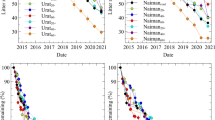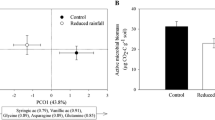Abstract
The litter decomposition, nutrient patterns, as well as nutrient release and soil nutrient contents were determined in response to nitrogen (N) and phosphorus (P) addition and drought treatments following long-term vegetation recovery. The litter decomposition rate decreased with vegetation recovery, due to changes in litter quality, soil nutrient availability, and soil enzyme activity. Nitrogen addition promoted litter decomposition in the early recovery stages but inhibited decomposition in the later stages, indicating a shift in the nutrient limitations to litter decomposition with succession. Neither N nor P addition had any effect on the release of litter carbon (C), whereas N addition inhibited litter N release. In addition, drought decreased litter decomposition and nutrient release during the vegetation recovery process. Our findings suggest that litter quality, soil nutrient availability, and moisture at different vegetation recovery stages should be considered when modeling the C cycle and nutrient dynamics in these ecosystems.






Similar content being viewed by others
References
Ågren GI, Bosatta E, Magill AH (2001) Combining theory and experiment to understand effects of inorganic nitrogen on litter decomposition. Oecologia 128:94–98
Baer SG, Blair JM (2008) Grassland establishment under varying resource availability: a test of positive and negative feedback. Ecology 89:1859–1871
Bebber DP, Watkinson SC, Boddy L, Darrah PR (2011) Simulated nitrogen deposition affects wood decomposition by cord-forming fungi. Oecologia 167:1177–1184
Berg B, McClaugherty C, Santo AVD, Johnson D (2001) Humus buildup in boreal forests: effects of litter fall and its N concentration. Can J For Res 31:988–998
Borken W, Savage K, Davidson EA, Trumbore SE (2006) Effects of experimental drought on soil respiration and radiocarbon efflux from a temperate forest soil. Glob Change Biol 12:177–193
Bremner JM, Mulvaney C (1982) Nitrogen-total. In: Klute A, Page A, Miller R, Keeney D (eds) Methods of soil analysis. Part 2. Chemical and microbiological properties. Am Soc Agron Soil Sci Soc Am, Madison, pp 595–624
Carreiro M, Sinsabaugh R, Repert D, Parkhurst D (2000) Microbial enzyme shifts explain litter decay responses to simulated nitrogen deposition. Ecology 81:2359–2365
Castellano MJ, Kaye JP, Lin H, Schmidt JP (2012) Linking carbon saturation concepts to nitrogen saturation and retention. Ecosystems 15:175–187
Chabrerie O, Laval K, Puget P, Desaire S, Alard D (2003) Relationship between plant and soil microbial communities along a successional gradient in a chalk grassland in north-western France. Appl Soil Ecol 24:43–56
Chen Y, Sayer EJ, Li Z, Mo Q, Li Y, Ding Y, Wang J, Lu X, Tang J, Wang F (2015) Nutrient limitation of woody debris decomposition in a tropical forest: contrasting effects of N and P addition. Funct Ecol 30:295–304
Clein JS, Schimel JP (1994) Reduction in microbial activity in Birch litter due to drying and rewetting event. Soil Biol Biochem 26:403–406
Cornwell WK, Cornelissen JH, Amatangelo K, Dorrepaal E, Eviner VT, Godoy O, Hobbie SE, Hoorens B, Kurokawa H, Pérez-Harguindeguy N (2008) Plant species traits are the predominant control on litter decomposition rates within biomes worldwide. Ecol Lett 11:1065–1071
Cramer VA, Hobbs RJ, Standish RJ (2008) What's new about old fields? Land abandonment and ecosystem assembly. Trends Ecol Evol 23:104–112
Dilly O (2001) Microbial respiratory quotient during basal metabolism and after glucose amendment in soils and litter. Soil Biol Biochem 33:117–127
Elser J, Fagan W, Kerkhoff A, Swenson N, Enquist B (2010) Biological stoichiometry of plant production: metabolism, scaling and ecological response to global change. New Phytol 186:593–608
Fang X, Zhao L, Zhou G, Huang W, Liu J (2015) Increased litter input increases litter decomposition and soil respiration but has minor effects on soil organic carbon in subtropical forests. Plant Soil 392:139–153
Fierer N, Nemergut D, Knight R, Craine JM (2010) Changes through time: integrating microorganisms into the study of succession. Res Microbiol 161:635–642
Frey SD, Knorr M, Parrent JL, Simpson RT (2004) Chronic nitrogen enrichment affects the structure and function of the soil microbial community in temperate hardwood and pine forests. For Ecol Manag 196:159–171
Gholz HL, Wedin DA, Smitherman SM, Harmon ME, Parton WJ (2000) Long-term dynamics of pine and hardwood litter in contrasting environments: toward a global model of decomposition. Glob Chang Biol 6:751–765
Göransson H, Godbold DL, Jones DL, Rousk J (2013) Bacterial growth and respiration responses upon rewetting dry forest soils: impact of drought-legacy. Soil Biol Biochem 57:477–486
Hobbie SE (2008) Nitrogen effects on decomposition: a five-year experiment in eight temperate sites. Ecology 89:2633–2644
Kang H, Fahey TJ, Bae K, Fisk M, Sherman RE, Yanai RD, See CR (2016) Response of forest soil respiration to nutrient addition depends on site fertility. Biogeochemistry 127:113–124
Klotzbücher T, Kaiser K, Guggenberger G, Gatzek C, Kalbitz K (2011) A new conceptual model for the fate of lignin in decomposing plant litter. Ecology 92:1052–1062
Liu P, Huang J, Han X, Sun OJ, Zhou Z (2006) Differential responses of litter decomposition to increased soil nutrients and water between two contrasting grassland plant species of Inner Mongolia, China. Appl Soil Ecol 34:266–275
Liu L, King JS, Booker FL, Giardina CP, Lee Allen H, Hu S (2009) Enhanced litter input rather than changes in litter chemistry drive soil carbon and nitrogen cycles under elevated CO2: a microcosm study. Glob Chang Biol 15:441–453
Liu L, Gundersen P, Zhang T, Mo J (2012) Effects of phosphorus addition on soil microbial biomass and community composition in three forest types in tropical China. Soil Biol Biochem 44:31–38
Lü M, Xie J, Wang C, Guo J, Wang M, Liu X, Chen Y, Chen G, Yang Y (2015) Forest conversion stimulated deep soil C losses and decreased C recalcitrance through priming effect in subtropical China. Biol Fertil Soils 51:857–867
Magill AH, Aber JD (1998) Long-term effects of experimental nitrogen additions on foliar litter decay and humus formation in forest ecosystems. Plant Soil 203:301–311
Makkonen M, Berg MP, Handa IT, Hättenschwiler S, Ruijven J, Bodegom PM, Aerts R (2012) Highly consistent effects of plant litter identity and functional traits on decomposition across a latitudinal gradient. Ecol Lett 15:1033–1041
Manzoni S, Jackson RB, Trofymow JA, Porporato A (2008) The global stoichiometry of litter nitrogen mineralization. Science 321:684–686
Nannipieri P, Giagnoni L, Renella G, Puglisi E, Ceccanti B, Masciandaro G, Fornasier F, Moscatelli MC, Marinari S (2012) Soil enzymology: classical and molecular approaches. Biol Fertil Soils 48:743–762
Ndagurwa HG, Dube JS, Mlambo D (2015) Decomposition and nutrient release patterns of mistletoe litters in a semi-arid savanna, southwest Zimbabwe. Aust Ecol 40:178–185
Nelson DW, Sommer LE (1980) Total nitrogen analysis of soil and plant tissues. J Assoc Offic Anal Chem 63:770–778
Nelson DW, Sommers LE (1982) Total carbon, organic carbon, and organic matter. In: Klute A, Page A, Miller R, Keeney D (eds) Methods of soil analysis. Part 2. Chemical and microbiological properties. Am Soc Agron Soil Sci Soc Am, Madison, pp 539–579
Norris MD, Avis PG, Reich PB, Hobbie SE (2013) Positive feedbacks between decomposition and soil nitrogen availability along fertility gradients. Plant Soil 367:347–361
Olander LP, Vitousek PM (2004) Biological and geochemical sinks for phosphorus in soil from a wet tropical forest. Ecosystems 7:404–419
Olson JS (1963) Energy storage and the balance of producers and decomposers in ecological systems. Ecology 44:322–331
Pathan SI, Ceccherini MT, Hansen MA, Giagnoni L, Ascher J, Arenella M, Sørensen SJ, Pietramellara G, Nannipieri P, Renella G (2015) Maize lines with different nitrogen use efficiency select bacterial communities with different β-glucosidase-encoding genes and glucosidase activity in the rhizosphere. Biol Fertil Soils 51:995–1004
Philippot L, Spor A, Hénault C, Bru D, Bizouard F, Jones CM, Sarr A, Maron P-A (2013) Loss in microbial diversity affects nitrogen cycling in soil. ISME J 7:1609–1619
Prescott C, Kabzems R, Zabek L (1999) Effects of fertilization on decomposition rate of Populus tremuloides foliar litter in a boreal forest. Can J For Res 29:393–397
R Core Team (2015) R: a language and environment for statistical computing. R Foundation for Statistical Computing, Vienna https://www.R-project.org
Saiya-Cork K, Sinsabaugh R, Zak D (2002) The effects of long term nitrogen deposition on extracellular enzyme activity in an Acer saccharum forest soil. Soil Biol Biochem 34:1309–1315
Sayer EJ, Heard MS, Grant HK, Marthews TR, Tanner EV (2011) Soil carbon release enhanced by increased tropical forest litterfall. Nat Clim Chang 1:304–307
Sluiter A, Hames B, Ruiz R, Scarlata C, Sluiter J, Templeton D, Crocker D (2008) Determination of structural carbohydrates and lignin in biomass. Laboratory analytical procedure, vol 1617. Midwest Research Institute, Battelle
Snyder JD, Trofymow JA (1984) A rapid accurate wet oxidation diffusion procedure for determining organic and inorganic carbon in plant and soil samples. Commun Soil Sci Plant Anal 15:587–597
Talhelm AF, Pregitzer KS, Zak DR (2009) Species-specific responses to atmospheric carbon dioxide and tropospheric ozone mediate changes in soil carbon. Ecol Lett 12:1219–1228
Trogisch S, He J-S, Hector A, Scherer-Lorenzen M (2016) Impact of species diversity, stand age and environmental factors on leaf litter decomposition in subtropical forests in China. Plant Soil 400:337–350
Voříšková J, Baldrian P (2013) Fungal community on decomposing leaf litter undergoes rapid successional changes. ISME J 7:477–486
Wang K, Shao R, Shangguan Z (2010) Changes in species richness and community productivity during succession on the Loess Plateau (China). Pol J Ecol 58:501–510
Wang J, Zhao M, Willms WD, Han G, Wang Z, Bai Y (2011) Can plant litter affect net primary production of a typical steppe in Inner Mongolia? J Veg Sci 22:367–376
Wang J, Liu L, Wang X, Chen Y (2015) The interaction between abiotic photodegradation and microbial decomposition under ultraviolet radiation. Glob Chang Biol 21:2095–2104
Xu S, Liu L, Sayer E (2013) Variability of above-ground litter inputs alters soil physicochemical and biological processes: a meta-analysis of litterfall-manipulation experiments. Biogeosciences 10:7423–7433
Zechmeister-Boltenstern S, Keiblinger KM, Mooshammer M, Penuelas J, Richter A, Sardans J, Wanek W (2015) The application of ecological stoichiometry to plant-microbial-soil organic matter transformations. Ecol Monogr 85:133–155
Zhang W, Wang S (2012) Effects of NH4+ and NO3− on litter and soil organic carbon decomposition in a Chinese fir plantation forest in South China. Soil Biol Biochem 47:116–122
Zhang K, Cheng X, Dang H, Ye C, Zhang Y, Zhang Q (2013) Linking litter production, quality and decomposition to vegetation succession following agricultural abandonment. Soil Biol Biochem 57:803–813
Zhong Y, Yan W, Shangguan Z (2016) The effects of nitrogen enrichment on soil CO2 fluxes depending on temperature and soil properties. Glob Ecol Biogeogr 25:475–488
Zhu W, Wang J, Zhang Z, Ren F, Chen L, He J-S (2016) Changes in litter quality induced by nutrient addition alter litter decomposition in an alpine meadow on the Qinghai-Tibet Plateau. Sci Rep 6:34290
Acknowledgments
The authors thank the editors and the anonymous reviewers for their insightful and constructive comments, which greatly contributed to improving the manuscript. This study was funded by the National Key Research and Development Program of China (2016YFC0501605), the National Science Foundation of China (41771549 and 41701336), the NSFC-Yunnan United fund (U1302267), the National Science Fund for Distinguished Young Scholars (31325005), the Postdoctoral Innovation Talent Support Program (BX201700198), the Natural Science Basic Research Plan in Shaanxi Province of China (2017JQ3004), and the Fundamental Research Funds for the Central Universities (3102016QD076).
Author information
Authors and Affiliations
Corresponding authors
Electronic supplementary material
ESM 1
(DOCX 3038 kb)
Rights and permissions
About this article
Cite this article
Zhong, Y., Yan, W., Wang, R. et al. Differential responses of litter decomposition to nutrient addition and soil water availability with long-term vegetation recovery. Biol Fertil Soils 53, 939–949 (2017). https://doi.org/10.1007/s00374-017-1242-9
Received:
Revised:
Accepted:
Published:
Issue Date:
DOI: https://doi.org/10.1007/s00374-017-1242-9




